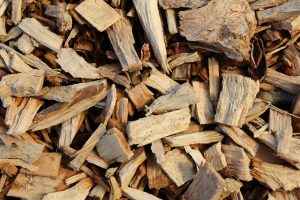Garden soils come in a variety of types–clay, silt, loam, and sand–and each of these classes will have their own variations and challenges. Gardening in silt and loam soils is probably the easiest. Clay and sandy soils, on the other hand, will take a little work but once you understand your soil you can learn to love it and make it even better with amendments such as mulch.
What is good about Clay Soil?
Although clay soil may be difficult to work with, it does have positive attributes. Clay soil is fertile and rich in minerals. Each clay particle is packed with places to hold water and fertilizer resulting in a high Cation Exchange Capacity. This means that it can hold essential nutrients and buffer against soil acidification better than other soil types, like sand. And, it means that clay soil needs less watering and fertilizer, saving gardeners a few dollars.
Clay soil also provides a great foundation for plants. Many annuals and perennials thrive in clay as their roots get a firm grip on the soil allowing them to survive extreme temperature and moisture fluctuations. There is also minimal heaving due to cycles of freezing and thawing with clay. So if you find yourself working with clay soil, embrace it. Clay soil leads to less water, less fertilizer, a better foundation, and increased hardiness for your plants in extreme weather.
Mulch for Clay Soil
When mulch is added to clay soil, an amendment takes place. The soil composition is amended for improved aeration and drainage while also working in fibrous materials. As the mulch slowly decomposes, the soil beneath is kept cooler and the bottom of your shoes tend to be cleaner. Here are some great mulch options to use on clay soil.
Readily available, wood chips have high carbon content which needs nitrogen during decomposition. When used as a mulch, wood chips will slowly breakdown when moisture is added, and it will break down due to the natural work of earthworms. This process slowly enriches the soil and the wood chips should be replenished as needed.
- Bark Mulches
Typically available in chunks or granules, bark mulches are made out of shredded tree bark. The granules are more suited for working into the soil, especially clay, while the chunks work best for spreading across the surface. Bark mulches can come in a variety of colors and will hold its color better than wood chips. It is also denser, making it more resistant to wind dispersion.
- Hulls/Shells
There are a number of mulches that are made from the hulls and shells of various plants. Nut shells from pecans and hazelnuts make long-lasting mulches that hold their color and add texture to the landscape.
Buckwheat hulls are finely textured and have a neutral coloring that complements plantings. They are susceptible to winding conditions and may emit a slight odor in hot, humid weather.
Cocoa bean hulls have a rich, chocolate color and a pleasing odor. This mulch tends to pack easily so it will need to be stirred up to ensure the plant roots are getting air. Also, cocoa bean hulls are toxic to dogs, so try something else if you have dogs in the area.
Mulch and Weeds
By adding a layer of mulch to clay soil you not only can help keep the house clean but can reduce the number of weeds. Mulch will smother weeds that germinate and enhance the amount of moisture that your soil retains leading to better plant growth. Mulch also slows down water run-off allowing clay soil more time to absorb, and store, the water. A layer of mulch is also cooler than exposed soil so it helps reduce temperatures in the garden.
Fra-Dor Landscape Supplies can cover all of your mulching needs. If you aren’t sure which type to pick, we can match the right mulch that will serve you best. Check out all of our offerings! If needed, we can deliver your selected mulch or you can stop by and pick it up, as well.
The post What is the Best Mulch for Gardeners with Clay Soil? appeared first on Frador.
from RSSMix.com Mix ID 8230377 https://ift.tt/2NqHxJV
via IFTTT

No comments:
Post a Comment